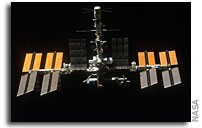NASA Space Station Lead Increment Scientist’s Highlights For the Week of April 16, 2012

(Highlights: Week of April 16, 2012) –Operations continued for the Burning And Suppression of Solids (BASS) investigation. BASS examines the burning and extinction characteristics of a wide variety of fuel samples in microgravity. The BASS investigation will guide strategies for extinguishing accidental fires in microgravity. BASS results contribute to the combustion computational models used in the design of fire detection and suppression systems in microgravity and on Earth.
The Japan Aerospace Exploration Agency’s Dynamism of Auxin Efflux Facilitators, CsPINs, Responsible for Gravity-regulated Growth and Development in Cucumber (CsPINS-2) investigation continues. The activity included seed watering, incubation, sample fixation and stowage. CsPINs refers to a protein that facilitates the formation of a physical feature upon roots during the seedling growth stage of plants. CsPINs studies how plants sense gravity as an environmental signal and use it for governing their morphology and growth orientation.
NanoRacks investigations continue. A bronze and gold electroplating experiment, a biological growth experiment, and a bacterial growth and antibiotic resistance experiment are among this set of investigations. NanoRacks are autonomous, self-contained, high school experiments which are plugged into a NanoRacks Platform aboard the station. The long-term goal of this project is to create a series of student projects that are sophisticated and economically efficient, allowing students to move beyond the classrooms and into low earth orbit with their research.
Through April 15, the Crew Earth Observation (CEO) team received 188,267 of the crew’s images for review and cataloging. For this investigation, station crew members photograph natural and human-made changes on Earth. These images provide researchers with key data to better understand the planet.
Crew members completed sessions with the Japan Aerospace Exploration Agency’s Space Sounds activity. They generated a constant amplitude resonance by rubbing the stick slowly and firmly against the outside rim of the Sound Emitting Object. They answered a questionnaire about how they felt the sound. Video and sound were recorded during the task. The result will be compared with one obtained before flight.








